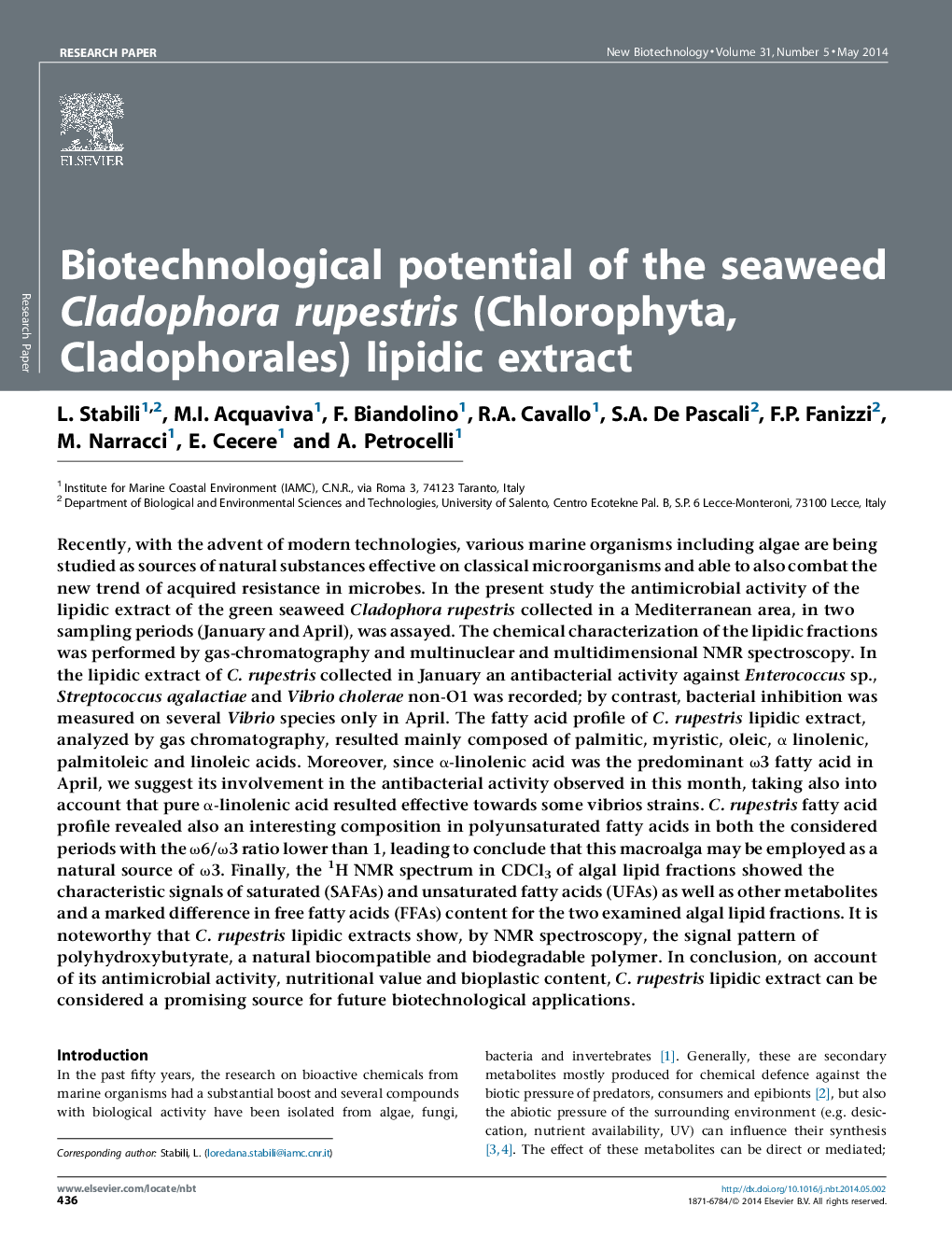| کد مقاله | کد نشریه | سال انتشار | مقاله انگلیسی | نسخه تمام متن |
|---|---|---|---|---|
| 10235006 | 44963 | 2014 | 9 صفحه PDF | دانلود رایگان |
عنوان انگلیسی مقاله ISI
Biotechnological potential of the seaweed Cladophora rupestris (Chlorophyta, Cladophorales) lipidic extract
دانلود مقاله + سفارش ترجمه
دانلود مقاله ISI انگلیسی
رایگان برای ایرانیان
موضوعات مرتبط
مهندسی و علوم پایه
مهندسی شیمی
بیو مهندسی (مهندسی زیستی)
پیش نمایش صفحه اول مقاله

چکیده انگلیسی
Recently, with the advent of modern technologies, various marine organisms including algae are being studied as sources of natural substances effective on classical microorganisms and able to also combat the new trend of acquired resistance in microbes. In the present study the antimicrobial activity of the lipidic extract of the green seaweed Cladophora rupestris collected in a Mediterranean area, in two sampling periods (January and April), was assayed. The chemical characterization of the lipidic fractions was performed by gas-chromatography and multinuclear and multidimensional NMR spectroscopy. In the lipidic extract of C. rupestris collected in January an antibacterial activity against Enterococcus sp., Streptococcus agalactiae and Vibrio cholerae non-O1 was recorded; by contrast, bacterial inhibition was measured on several Vibrio species only in April. The fatty acid profile of C. rupestris lipidic extract, analyzed by gas chromatography, resulted mainly composed of palmitic, myristic, oleic, α linolenic, palmitoleic and linoleic acids. Moreover, since α-linolenic acid was the predominant Ï3 fatty acid in April, we suggest its involvement in the antibacterial activity observed in this month, taking also into account that pure α-linolenic acid resulted effective towards some vibrios strains. C. rupestris fatty acid profile revealed also an interesting composition in polyunsaturated fatty acids in both the considered periods with the Ï6/Ï3 ratio lower than 1, leading to conclude that this macroalga may be employed as a natural source of Ï3. Finally, the 1H NMR spectrum in CDCl3 of algal lipid fractions showed the characteristic signals of saturated (SAFAs) and unsaturated fatty acids (UFAs) as well as other metabolites and a marked difference in free fatty acids (FFAs) content for the two examined algal lipid fractions. It is noteworthy that C. rupestris lipidic extracts show, by NMR spectroscopy, the signal pattern of polyhydroxybutyrate, a natural biocompatible and biodegradable polymer. In conclusion, on account of its antimicrobial activity, nutritional value and bioplastic content, C. rupestris lipidic extract can be considered a promising source for future biotechnological applications.
ناشر
Database: Elsevier - ScienceDirect (ساینس دایرکت)
Journal: New Biotechnology - Volume 31, Issue 5, 25 September 2014, Pages 436-444
Journal: New Biotechnology - Volume 31, Issue 5, 25 September 2014, Pages 436-444
نویسندگان
L. Stabili, M.I. Acquaviva, F. Biandolino, R.A. Cavallo, S.A. De Pascali, F.P. Fanizzi, M. Narracci, E. Cecere, A. Petrocelli,